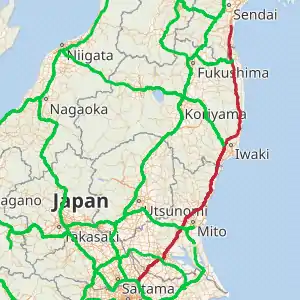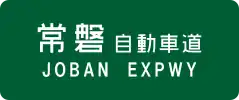Jōban Expressway
The Jōban Expressway (常磐自動車道, Jōban Jidōsha-dō), abbreviated Jōban-dō (常磐道), is a national expressway in Japan. It is owned and operated by East Nippon Expressway Company. It is signed E6 under the Ministry of Land, Infrastructure, Transport and Tourism's "2016 Proposal for Realization of Expressway Numbering."[3]
| |
|---|---|

| |
| Route information | |
| Length | 300.4 km[1] (186.7 mi) |
| Existed | 1981[2]–present |
| Major junctions | |
| South end | Misato Junction in Misato, Saitama |
| North end | Watari Interchange Miyagi Prefecture Route 269 in Watari, Miyagi |
| Location | |
| Major cities | Kashiwa, Tsukuba, Tsuchiura, Mito, Hitachi, Iwaki, Natori, Sendai |
| Highway system | |
| National highways of Japan Expressways of Japan | |
Route description
The expressway is an important route connecting the greater Tokyo area with Mito, the capital of Ibaraki Prefecture. Beyond Mito, the expressway follows a northerly route along the coast of the Pacific Ocean to the city of Iwaki in Fukushima Prefecture. Continuing north along the coast, the expressway enters the greater Sendai area. The expressway supplements the Tōhoku Expressway as an access route between Tokyo and the Tōhoku region.
For most of its length the expressway parallels National Route 6 and the Jōban Line of East Japan Railway Company.
The expressway gets within about six kilometers from the damaged Fukushima Daiichi Nuclear Power Plant. On a 14.3 km (8.9 mi) of the expressway opened on 1 March 2015, signs update drivers about what the radiation level is in the impacted area.[4]
Naming
Jōban is a kanji acronym consisting of two characters. Each character represents a former province of Japan that is passed through by the route: Hitachi Province (常陸国) representing present-day Ibaraki Prefecture and Iwaki Province (磐城国) representing the eastern portion of present-day Fukushima Prefecture
The expressway carries the Jōban Expressway name from the origin at Misato Junction to Watari Interchange. From Watari Interchange to the expected terminus at Tomiya-kita Interchange, the Jōban Expressway name is currently an official designation only.[5] The section from Watari Interchange to Sendaikō-kita Interchange is the Sendai-Tōbu Road, the section from Sendaikō-kita Interchange to Rifu Junction is the Sanriku Expressway (Senen Road), and the section from Rifu Junction to the terminus is the Sendai-Hokubu Road. It is unknown if the naming of these sections will be changed upon completion of the Jōban Expressway.
The expressway has a speed limit of 70 km/h between Iwaki-chūō Interchange and its northern terminus at Watari, a limit of 80 km/h between its southern terminus and Kashiwa Interchange and between Hitachiminami-Ōta and Iwaki-chūō interchanges, and a speed limit of 100 km/h on the remainder of the expressway.
History
The first section of the expressway was opened in 1981. The section from Jōban-Tomioka Interchange to Watari Interchange is under construction,[6] and extensions and upgrades to the existing Sendai road network are also planned.[7]
List of junctions and features
- PA - parking area, SA - service area, TB - toll gate
| Prefecture | Location | km | mi | Exit | Name | Destinations | Notes |
|---|---|---|---|---|---|---|---|
| Saitama | Misato | 0.0 | 0.0 | 1 | Misato | Southern terminus, expressway continues as the Misato Route of the Shuto Expressway network; Tokyo Gaikan Expressway exit 80 | |
| 2.2– 2.4 | 1.4– 1.5 | Misato Tunnel | |||||
| 4.2 | 2.6 | TB | Misato | ||||
| 4.2 | 2.6 | 1-1 | Misato-ryōkinjo | Saitama Prefecture Route 52 (Koshigaya Nagareyama Route) | Smart interchange; northbound entrance, southbound exit | ||
| Chiba–Saitama prefecture border | 4.9 6.3 | 3.0 3.9 | Edogawa Bridge over the Edo River | ||||
| Chiba | Nagareyama | 6.1 | 3.8 | 1-2 | Nagareyama | Chiba Prefectuere Route 5 (Matsudo Noda Route) | |
| Kashiwa | 10.8 | 6.7 | 2 | Kashiwa | |||
| Chiba–Ibaraki prefecture border | 13.0 13.8 | 8.1 8.6 | Tonegawa Bridge over the Tone River | ||||
| Ibaraki | Moriya | 15.5 | 9.6 | SA | Moriya | ||
| Tsukubamirai | 19.1 | 11.9 | 3 | Yawara | |||
| 20.4– 20.6 | 12.7– 12.8 | Kokaigawa Bridge over the Kokai River | |||||
| Tsukuba | 30.3 | 18.8 | 4 | Yatabe | Ibaraki Prefecture Route 19 (Toride Tsukuba Route) | ||
| 34.6 | 21.5 | 4-1 | Tsukuba | Ken-Ō Expressway exit 80 | |||
| 36.1 | 22.4 | PA | Yatabe-higashi | ||||
| Tsuchiura | 38.7 | 24.0 | 5 | Sakura-Tsuchiura | |||
| 46.6 | 29.0 | 6 | Tsuchiura-kita | ||||
| Kasumigaura | 50.4 | 31.3 | PA | Chiyoda | |||
| 54.7 | 34.0 | 7 | Chiyoda-Ishioka | ||||
| Kasumigaura–Ishioka border | 56.2 56.8 | 34.9 35.3 | Koisegawa Bridge over the Koise River | ||||
| Ishioka | 60.9 | 37.8 | 7-1 | Ishioka-Omitama | Smart interchange | ||
| Omitama | 63.2 | 39.3 | PA | Minori | |||
| Kasama | 69.1 | 42.9 | 8 | Iwama | Ibaraki Prefecture Route 43 (Ibaraki Iwama Route) | ||
| 71.2– 71.4 | 44.2– 44.4 | Hinumagawa Bridge over the Hinuma River | |||||
| 72.8 | 45.2 | SA / 8-1 | Tomobe | Ibaraki Prefecture routes 16 (Ōarai Tomobe Route) / 52 (Ishioka Shirosato Route) | Smart interchange | ||
| 74.0 | 46.0 | 8-2 | Tomobe | ||||
| Mito | 82.0 | 51.0 | 9 | Mito | |||
| 85.6 | 53.2 | PA | Tano | ||||
| 86.6– 87.0 | 53.8– 54.1 | Tano Overpass | |||||
| 87.7 | 54.5 | 9-1 | Mito-kita | Smart interchange; northbound exit, southbound entrance | |||
| 88.2– 88.7 | 54.8– 55.1 | Nakagawa Bridge over the Naka River | |||||
| Naka | 93.8 | 58.3 | 10 | Naka | Ibaraki Prefecture Route 65 (Naka Inter Route) | ||
| Tōkai | 101.7 | 63.2 | PA / 10-1 | Tōkai | Ibaraki Prefecture Route 62 (Hitachinaka Port Yamagata Route) | Smart interchange | |
| Naka–Hitachi border | 102.8– 103.5 | 63.9– 64.3 | Kujigawa Bridge over the Kuji River | ||||
| Hitachi | 105.3 | 65.4 | 11 | Hitachiminami-Ōta | |||
| Hitachiōta | 108.4– 110.8 | 67.4– 68.8 | Hitachi Tunnel | ||||
| Hitachi | 110.8– 112.6 | 68.8– 70.0 | Ōkubo tunnels | ||||
| 112.6– 113.9 | 70.0– 70.8 | Suwa tunnels | |||||
| 114.4– 115.2 | 71.1– 71.6 | Narusawa Tunnel | |||||
| 115.2– 117.0 | 71.6– 72.7 | Sukegawa Tunnel | |||||
| 117.5 | 73.0 | PA / 11-1 | Hitachi-chūō | ||||
| 118.1– 118.2 | 73.4– 73.4 | Sukegawa Tunnel | |||||
| 118.2– 118.8 | 73.4– 73.8 | Daiōin Tunnel | |||||
| 119.1– 121.0 | 74.0– 75.2 | Kurakake Tunnel | |||||
| 122.7– 122.9 | 76.2– 76.4 | Ogitsu Tunnel | |||||
| 124.3 | 77.2 | 12 | Hitachi-kita | Ibaraki Prefecture Route 10 (Hitachi Iwaki Route) | |||
| 126.2– 126.5 | 78.4– 78.6 | Jūō Tunnel | |||||
| Takahagi | 135.2 | 84.0 | 13 | Takahagi | Ibaraki Prefecture Route 67 (Takahagi Inter Route) | ||
| Kitaibaraki | 136.6 | 84.9 | SA | Nakagō | |||
| 142.4 | 88.5 | 14 | Kitaibaraki | Ibaraki Prefecture Route 69 (Kitaibaraki Inter Route) | |||
| 146.7– 148.1 | 91.2– 92.0 | Sekinami Tunnel | |||||
| 148.3– 148.5 | 92.1– 92.3 | Sekimoto Tunnel | |||||
| 150.3 | 93.4 | PA | Sekimoto | ||||
| Fukushima | Iwaki | 154.5 | 96.0 | 15 | Iwaki-Nakoso | ||
| 161.0 | 100.0 | 15-1 | Iwaki-Onahama | Fukushima Prefecture Route 20 (Iwaki Kamimisaka Ono Route) | Exit opens in 2021 | ||
| 167.1 | 103.8 | 16 | Iwaki-Yumoto | Fukushima Prefecture Route 14 (Iwaki Ishikawa Route) | |||
| 169.4 | 105.3 | PA | Yunotake | ||||
| 171.2 | 106.4 | 16-1 | Iwaki | ||||
| 175.5 | 109.1 | 17 | Iwaki-chūō | ||||
| 179.4– 179.8 | 111.5– 111.7 | Natsuigawa Bridge | |||||
| 185.7 | 115.4 | PA | Yotsukura | ||||
| 188.3 | 117.0 | 18 | Iwaki-Yotsukura | Fukushima Prefecture Route 35 (Iwaki Namie Route) | |||
| 194.3– 194.8 | 120.7– 121.0 | Ōhisa Tunnel | |||||
| Hirono | 202.1 | 125.6 | 19 | Hirono | Fukushima Prefecture Route 393 (Kamikitaba Shimokitaba Route) | ||
| Naraha | 197.5– 198.9 | 122.7– 123.6 | Kidogawa Bridge | ||||
| 207.4 | 128.9 | PA / 19-1 | Naraha | Fukushima Prefecture Route 35 (Iwaki Namie Route) | Smart interchange | ||
| Tomioka | 218.5 | 135.8 | 20 | Jōban-Tomioka | Fukushima Prefecture Route 36 (Ono Tomioka Route) | ||
| Ōkuma | 222.5 | 138.3 | 20-1 | Ōkuma | Fukushima Prefecture Route 251 (Oragahama Nogami Route) | ||
| Futaba | 227.9 | 141.6 | 20-2 | Jōban-Futaba | Fukushima Prefecture Route 256 (Ide Nagatsuka Route) | ||
| Namie | 232.8 | 144.7 | 21 | Namie | |||
| Minamisōma | 251.2 | 156.1 | 22 | Minami-Sōma | Fukushima Prefecture Route 12 (Haramachi Kawamata Route) | ||
| 257.7 | 160.1 | SA / 22-1 | Minami-Sōma Kashima | Fukushima Prefecture Route 34 (Sōma Namie Route) | Smart interchange; SIC only open between 06:00-22:00 | ||
| Sōma | 265.6 | 165.0 | 23 | Sōma | |||
| Shinchi | 274.1 | 170.3 | 24 | Shinchi | |||
| Miyagi | Yamamoto | 280.6 | 174.4 | 24-1 | Yamamoto-minami | Miyagi Prefecture Route 44 (Kakuda Yamamoto Route) | Smart interchange |
| 288.9 | 179.5 | 25 | Yamamoto | ||||
| Watari | 295.0 | 183.3 | PA / 25-1 | Torinoumi | Miyagi Prefecture Route 38 (Sōma Watari Route) via Watari SIC Line | Smart interchange | |
| 300.4 | 186.7 | 1 | Watari | Miyagi Prefecture Route 269 (Watari Inter Route) | |||
| Expressway continues as | |||||||
1.000 mi = 1.609 km; 1.000 km = 0.621 mi
| |||||||
References
- "E-NEXCO Expressway Data". Archived from the original on 2007-12-13. Retrieved 2008-04-13.
- "History of Tsukuba City". Retrieved 2008-04-16.
- "Japan's Expressway Numbering System". www.mlit.go.jp.
- Jun Hongo (19 February 2015). "Highway to Open Near Fukushima Nuclear Plant; No Exits Allowed". The Wall Street Journal. Retrieved 11 October 2019.
- Ministry of Land, Infrastructure and Transport. "High Standard Trunk Road Map" (PDF). Archived from the original (pdf) on September 20, 2011. Retrieved 2008-04-13.
- "E-NEXCO Opening Schedule". Retrieved 2008-04-15.
- Ministry of Land, Infrastructure and Transport, Tohoku Regional Development Bureau. "Sendai Hokubu Road Profile". Archived from the original on 2008-04-02. Retrieved 2008-04-16.CS1 maint: multiple names: authors list (link)
External links
| Wikimedia Commons has media related to Joban Expressway. |
- (in Japanese) East Nippon Expressway Company
